Plant Science Research Weekly: December 1, 2023
Review: Paternal imprinting in Marchantia polymorpha
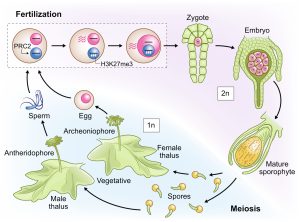 Humans and flowering plants spend most of their lives in a diploid state with two copies of each chromosome in most cells, but to reproduce they produce haploid gametes through meiosis. By contrast, bryophytes (liverworts, hornworts, and mosses), spend most of their lives in the haploid state. They produce gametes through mitosis and differentiation, and then very briefly experience a diploid state before meiosis leads again to the dominant, haploid state. The process of toggling between diploid and haploids is actually quite complicated, as some genes should only be active in one state or the other, or when inherited from one parent or the other. Shutting off of specific genes by parent-of-origin is known as imprinting, and usually involves the polycomb repressive complex and histone methylation (H3K27me3). Recently, Montgomery and Berger and colleagues identified a new type of selective gene silencing in the liverwort Marchantia, which involves the complete silencing of the paternal genome for the duration of the diploid stage – effectively rendering it haploid. This review discusses this novel finding in the context of other forms of imprinting and the evolution of land plants. Check it out! (Summary by Mary Williams @PlantTeaching) New Phytol. doi.org/10.1111/nph.19377
Humans and flowering plants spend most of their lives in a diploid state with two copies of each chromosome in most cells, but to reproduce they produce haploid gametes through meiosis. By contrast, bryophytes (liverworts, hornworts, and mosses), spend most of their lives in the haploid state. They produce gametes through mitosis and differentiation, and then very briefly experience a diploid state before meiosis leads again to the dominant, haploid state. The process of toggling between diploid and haploids is actually quite complicated, as some genes should only be active in one state or the other, or when inherited from one parent or the other. Shutting off of specific genes by parent-of-origin is known as imprinting, and usually involves the polycomb repressive complex and histone methylation (H3K27me3). Recently, Montgomery and Berger and colleagues identified a new type of selective gene silencing in the liverwort Marchantia, which involves the complete silencing of the paternal genome for the duration of the diploid stage – effectively rendering it haploid. This review discusses this novel finding in the context of other forms of imprinting and the evolution of land plants. Check it out! (Summary by Mary Williams @PlantTeaching) New Phytol. doi.org/10.1111/nph.19377
Review: The exocyst complex is targeted by pathogen effectors
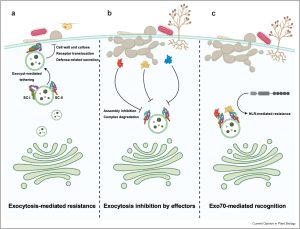 The exocyst complex is a conserved octameric protein complex in eukaryotic cells. Its primary function is to tether secretory vesicles to the plasma membrane during the exocytosis process, and it is also involved in autophagy and host-pathogen interactions. Intriguingly, EXO70, one of the subunits of the exocyst complex, is present in a single copy in animals and fungi, but has expanded into a large protein family in plants. In a recent review, De la Concepcion brings together current research about the exocyst complex, including its 3D structure and investigations into the functional diversification of EXO70 in plants. Most notably, the review focuses on the different ways that the exocyst complex helps plants combat pathogens, for example through direct or indirect interactions with immune proteins. Not surprisingly given its role in immunity, the exocyst complex is targeted by several pathogen effectors, which are summarized in a useful table listing pathogen effectors and their targeted exocyst subunits. The review ends by raising open important questions about the diversification of exocyst subunits and pathogen effector–exocyst interactions. (Summary by Xiaohui Li @Xiao_hui_Li) Curr. Opin. Plant Biol. 10.1016/j.pbi.2023.102482. (For further insights into the exocyst complex’s role in autophagy, refer to Viktor Žárský’s detailed review in FEBS Letters 10.1002/1873-3468.14430.)
The exocyst complex is a conserved octameric protein complex in eukaryotic cells. Its primary function is to tether secretory vesicles to the plasma membrane during the exocytosis process, and it is also involved in autophagy and host-pathogen interactions. Intriguingly, EXO70, one of the subunits of the exocyst complex, is present in a single copy in animals and fungi, but has expanded into a large protein family in plants. In a recent review, De la Concepcion brings together current research about the exocyst complex, including its 3D structure and investigations into the functional diversification of EXO70 in plants. Most notably, the review focuses on the different ways that the exocyst complex helps plants combat pathogens, for example through direct or indirect interactions with immune proteins. Not surprisingly given its role in immunity, the exocyst complex is targeted by several pathogen effectors, which are summarized in a useful table listing pathogen effectors and their targeted exocyst subunits. The review ends by raising open important questions about the diversification of exocyst subunits and pathogen effector–exocyst interactions. (Summary by Xiaohui Li @Xiao_hui_Li) Curr. Opin. Plant Biol. 10.1016/j.pbi.2023.102482. (For further insights into the exocyst complex’s role in autophagy, refer to Viktor Žárský’s detailed review in FEBS Letters 10.1002/1873-3468.14430.)
Review: CLAVATA signaling in plant-environment interactions
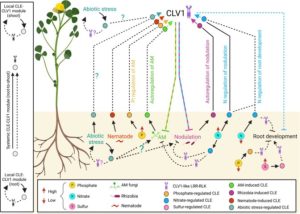 CLAVATA 3/EMBRYO SURROUNDING REGION-related (CLE) peptides and CLAVATA type receptors have been well charecterized for their role in root and shoot apical meristem maintenance in Arabidopsis. CLE peptides are also referred to as “peptide hormones” for their role in contolling physiological and developmental changes in plants. In this review by Bashyal et al., the roles of these peptides in regulating plant responses to various environmental stimuli is comprehensively summarized. CLAVATA signaling has diverse roles ranging from plant developmental adaptations to nutrient availability, responses to abiotic and biotic stimuli, and symbiotic relationships with rhizobia and arbuscular mycorrhiza fungi. The review also describes interesting studies on CLE-like signaling peptides from parasitic nematodes that hijack the plant-CLAVATA signaling pathway for their own benefit. The authors anticipate that future functional characterization through advanced bioinformatic tools will help in understanding how CLE-specific plant responses integrate plant physiology and the environment. (Summary by Indrani Kakati Baruah @Indranik333) Plant Physiol. 10.1093/plphys/kiad591
CLAVATA 3/EMBRYO SURROUNDING REGION-related (CLE) peptides and CLAVATA type receptors have been well charecterized for their role in root and shoot apical meristem maintenance in Arabidopsis. CLE peptides are also referred to as “peptide hormones” for their role in contolling physiological and developmental changes in plants. In this review by Bashyal et al., the roles of these peptides in regulating plant responses to various environmental stimuli is comprehensively summarized. CLAVATA signaling has diverse roles ranging from plant developmental adaptations to nutrient availability, responses to abiotic and biotic stimuli, and symbiotic relationships with rhizobia and arbuscular mycorrhiza fungi. The review also describes interesting studies on CLE-like signaling peptides from parasitic nematodes that hijack the plant-CLAVATA signaling pathway for their own benefit. The authors anticipate that future functional characterization through advanced bioinformatic tools will help in understanding how CLE-specific plant responses integrate plant physiology and the environment. (Summary by Indrani Kakati Baruah @Indranik333) Plant Physiol. 10.1093/plphys/kiad591
Review: Increasing yields of barley and wheat through inflorescence architecture
 The Triticeae is an important tribe of crops that contains both barley and wheat. As the global population increases, the yield of Triticeae crops must increase to meet global food demands. An important factor influencing yield is grain number per spike, which is affected by inflorescence architecture. Here, Zhang et al. suggest that altering the inflorescence architecture in Triticeae crops by increasing the amount of branching and the number of spikelets per inflorescence could lead to higher yields. They highlight many key regulators that could be targeted to achieve this, for instance the AP2-ERF (APETALA2/ETHYLENE RESPONSIVE FACTOR) transcription factor COMPOSITUM 2 in barley which when mutated results in a highly branched spike. Another potential target is the miRNA156-SPL (SQUAMOSA promoter binding protein-like) module; SPL knockout wheat lines have decreased spikelet number, so increasing SPL expression might increase spikelet number. Such regulators could be targeted using CRISPR/Cas9 genome editing or by searching for beneficial alleles in seed stores or wild relatives, leading to increased yields of these important crops. (Summary by Rose McNelly @rose_mcn) J. Exp. Bot. 10.1093/jxb/erad386
The Triticeae is an important tribe of crops that contains both barley and wheat. As the global population increases, the yield of Triticeae crops must increase to meet global food demands. An important factor influencing yield is grain number per spike, which is affected by inflorescence architecture. Here, Zhang et al. suggest that altering the inflorescence architecture in Triticeae crops by increasing the amount of branching and the number of spikelets per inflorescence could lead to higher yields. They highlight many key regulators that could be targeted to achieve this, for instance the AP2-ERF (APETALA2/ETHYLENE RESPONSIVE FACTOR) transcription factor COMPOSITUM 2 in barley which when mutated results in a highly branched spike. Another potential target is the miRNA156-SPL (SQUAMOSA promoter binding protein-like) module; SPL knockout wheat lines have decreased spikelet number, so increasing SPL expression might increase spikelet number. Such regulators could be targeted using CRISPR/Cas9 genome editing or by searching for beneficial alleles in seed stores or wild relatives, leading to increased yields of these important crops. (Summary by Rose McNelly @rose_mcn) J. Exp. Bot. 10.1093/jxb/erad386
RALF4 prevents pollen tubes from growing crazy
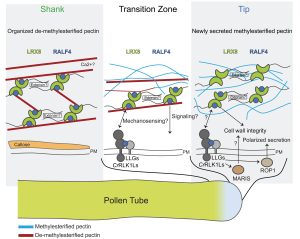 Pollen tubes are characterized by extremely fast elongation growth. Previously, small peptides known as RALFs (RAPID ALKALINIZATION FACTORs) were identified as signaling peptides, some with a role in pollen tube growth; for instance, RALF4/19 are important in maintaining the cell wall integrity of pollen tubes. RALF peptides bind to a membrane-integral protein complex consisting of LLGs [LORELEI-like GLYCOLPHOSPHATIDYLINOSITOL (GPI)-ANCHORED PROTEINS] and CrRLK1Ls (Catharanthus roseus RLK1-like receptor kinases). In addition, RALF peptides also bind to cell wall-anchored LRX (LEUCINE-RICH REPEAT EXTENSIN) proteins. When RALF4 binds to LRX8, it exposes an alkaline surface patch hypothesized to interact with negatively charged cell wall polysaccharides like pectin. In a recent study, Moussu et al. used the Arabidopsis pollen tube to explore the LRX8-RALF4 complex’s role in cell wall patterning. Using biochemical assays, they discovered that the LRX8-RALF4 complex directly binds to oligogalacturonans (OGs, a type of pectin). Notably, neither RALF4 nor LRX8 alone could bind to OGs independently. This interaction is specific to demethylated pectins, found predominantly in the pollen tube’s shank. Super-resolution imaging with immunolabeling revealed that LRX8 and RALF4 not only colocalize but also associate with pectin, creating a reticulated pattern along the pollen tube cell wall. Surprisingly, RALF4 is present along the pollen tube cell wall as an integral component colocalizing with LRX8. In addition, they found that mutations of the exposed alkaline surface of RALF4 lead to abnormal cell wall patterning, increased pollen tube growth rates, and premature bursting. Collectively, these discoveries highlight the critical role of the LRX8-RALF4-pectin association in the assembly and patterning of the pollen tube cell wall. (Summary by Xiaohui Li @Xiao_hui_Li) Science 10.1126/science.adi4720. For an extended analysis of this study’s background and future directions, and to see a wonderful image of pectin network in an Arabidopsis pollen tube, I recommend to read the excellent perspective article from Debra Mohnen in Science (10.1126/science.adl1198).
Pollen tubes are characterized by extremely fast elongation growth. Previously, small peptides known as RALFs (RAPID ALKALINIZATION FACTORs) were identified as signaling peptides, some with a role in pollen tube growth; for instance, RALF4/19 are important in maintaining the cell wall integrity of pollen tubes. RALF peptides bind to a membrane-integral protein complex consisting of LLGs [LORELEI-like GLYCOLPHOSPHATIDYLINOSITOL (GPI)-ANCHORED PROTEINS] and CrRLK1Ls (Catharanthus roseus RLK1-like receptor kinases). In addition, RALF peptides also bind to cell wall-anchored LRX (LEUCINE-RICH REPEAT EXTENSIN) proteins. When RALF4 binds to LRX8, it exposes an alkaline surface patch hypothesized to interact with negatively charged cell wall polysaccharides like pectin. In a recent study, Moussu et al. used the Arabidopsis pollen tube to explore the LRX8-RALF4 complex’s role in cell wall patterning. Using biochemical assays, they discovered that the LRX8-RALF4 complex directly binds to oligogalacturonans (OGs, a type of pectin). Notably, neither RALF4 nor LRX8 alone could bind to OGs independently. This interaction is specific to demethylated pectins, found predominantly in the pollen tube’s shank. Super-resolution imaging with immunolabeling revealed that LRX8 and RALF4 not only colocalize but also associate with pectin, creating a reticulated pattern along the pollen tube cell wall. Surprisingly, RALF4 is present along the pollen tube cell wall as an integral component colocalizing with LRX8. In addition, they found that mutations of the exposed alkaline surface of RALF4 lead to abnormal cell wall patterning, increased pollen tube growth rates, and premature bursting. Collectively, these discoveries highlight the critical role of the LRX8-RALF4-pectin association in the assembly and patterning of the pollen tube cell wall. (Summary by Xiaohui Li @Xiao_hui_Li) Science 10.1126/science.adi4720. For an extended analysis of this study’s background and future directions, and to see a wonderful image of pectin network in an Arabidopsis pollen tube, I recommend to read the excellent perspective article from Debra Mohnen in Science (10.1126/science.adl1198).
Lateral root branching promoted by ammonia borane-dependent H2
 Molecular hydrogen (H2) has been shown to have several cellular benefits, most notably serving as an antioxidant. Its effects in humans and plants have been primarily assayed using hydrogen-rich water (HRW, produced by bubbling H2 into water), but slower, more persistent release of H2 has been demonstrated from solid ammonia borane (NH3BH3). Here, Wang et al. examined how ammonia borane affects root growth, using hydroponically grown tomatoes treated with ammonia borane (AB). Upon treatment with AB, roots showed an increase in expression level of several genes involved in the synthesis of phytomelatonin and an accompanying increase in phytomelatonin levels. The AB-promoted increase in root branching is suppressed by an inhibitor of phytomelatonin synthesis, and root branching is enhanced by exogenous phytomelatonin treatment, suggesting that the effects of AB are mediated through phytomelatonin. AB or phytomelatonin further led to an increase in expression on several auxin-signaling genes, suggesting that auxin has a role in this response. (Summary by Mary Williams @PlantTeaching) Plant Physiol. 10.1093/plphys/kiad595
Molecular hydrogen (H2) has been shown to have several cellular benefits, most notably serving as an antioxidant. Its effects in humans and plants have been primarily assayed using hydrogen-rich water (HRW, produced by bubbling H2 into water), but slower, more persistent release of H2 has been demonstrated from solid ammonia borane (NH3BH3). Here, Wang et al. examined how ammonia borane affects root growth, using hydroponically grown tomatoes treated with ammonia borane (AB). Upon treatment with AB, roots showed an increase in expression level of several genes involved in the synthesis of phytomelatonin and an accompanying increase in phytomelatonin levels. The AB-promoted increase in root branching is suppressed by an inhibitor of phytomelatonin synthesis, and root branching is enhanced by exogenous phytomelatonin treatment, suggesting that the effects of AB are mediated through phytomelatonin. AB or phytomelatonin further led to an increase in expression on several auxin-signaling genes, suggesting that auxin has a role in this response. (Summary by Mary Williams @PlantTeaching) Plant Physiol. 10.1093/plphys/kiad595
Evolution of the thermostability of actin-depolymerizing factors enhances the adaptation of pollen germination to high temperature
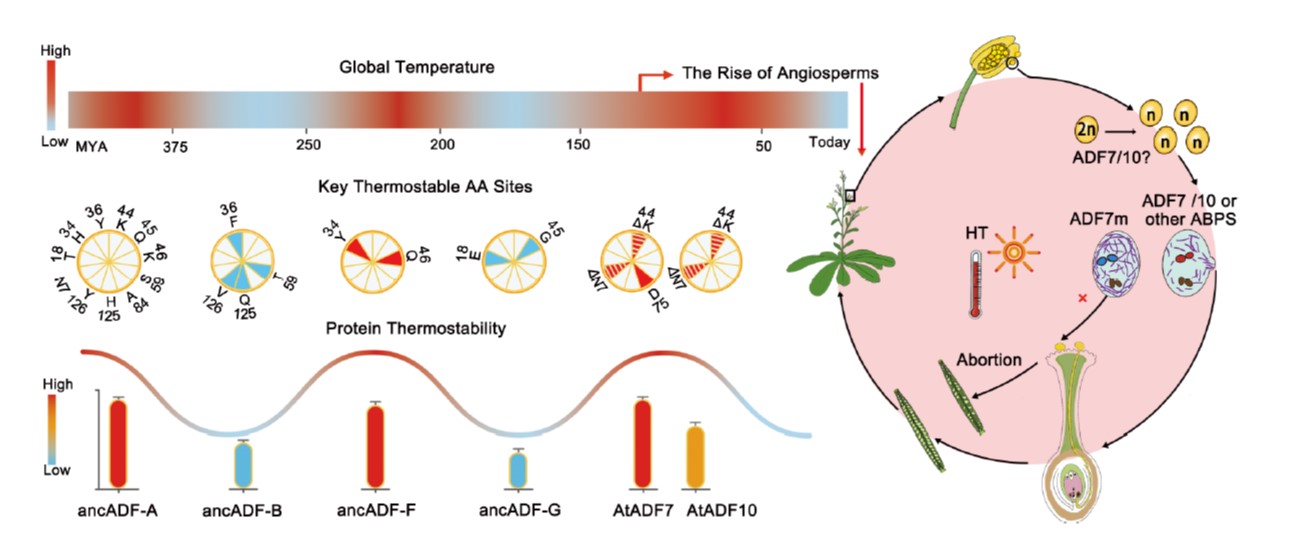 In angiosperms, pollen germination leads to a period of extensive polarized growth of the pollen tube, which carries the sperm nuclei to the ovule. Studies of tip growth in both pollen tubes and root hairs have contributed to a descriptive model that involves polarized vesicle movement along the cytoskeleton to release materials needed for growth, such as cell wall precursors, at the growing tip. Key to this is the rapid disassembly and reassembly of the actin filaments due to the action of numerous actin-binding proteins, including actin-depolymerizing factors (ADFs). Here, Qian et al. investigated the ADF protein family in plants. In Arabidopsis, ADF proteins expressed highly in pollen display remarkable thermal stability, remaining undenatured even after boiling, whereas other ADFs denature at much lower temperatures. Genetic studies revealed that the thermostable ADFs are needed for pollen germination at the high temperatures that can occur in summertime, e.g., 37 degrees. The authors identified a few key residues as critical for thermostability. They then examined ADF proteins across the plant lineage and identified sequences of ancestral proteins; their results showed a trend of increasing and decreasing thermostability over evolutionary time. Interestingly, the trend maps to the changing global temperature over the past few hundred million years, and the emergence of the pollen-specific thermostable forms coincide with the rise of angiosperms. (Summary by Mary Williams @PlantTeaching) Plant Cell 10.1093/plcell/koad280
In angiosperms, pollen germination leads to a period of extensive polarized growth of the pollen tube, which carries the sperm nuclei to the ovule. Studies of tip growth in both pollen tubes and root hairs have contributed to a descriptive model that involves polarized vesicle movement along the cytoskeleton to release materials needed for growth, such as cell wall precursors, at the growing tip. Key to this is the rapid disassembly and reassembly of the actin filaments due to the action of numerous actin-binding proteins, including actin-depolymerizing factors (ADFs). Here, Qian et al. investigated the ADF protein family in plants. In Arabidopsis, ADF proteins expressed highly in pollen display remarkable thermal stability, remaining undenatured even after boiling, whereas other ADFs denature at much lower temperatures. Genetic studies revealed that the thermostable ADFs are needed for pollen germination at the high temperatures that can occur in summertime, e.g., 37 degrees. The authors identified a few key residues as critical for thermostability. They then examined ADF proteins across the plant lineage and identified sequences of ancestral proteins; their results showed a trend of increasing and decreasing thermostability over evolutionary time. Interestingly, the trend maps to the changing global temperature over the past few hundred million years, and the emergence of the pollen-specific thermostable forms coincide with the rise of angiosperms. (Summary by Mary Williams @PlantTeaching) Plant Cell 10.1093/plcell/koad280
Subsidiary cells mediate stomatal closure in maize
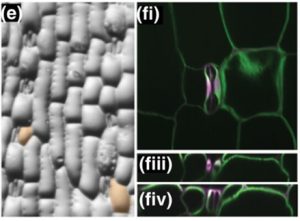 Stomata are pores on leaves which enable gas exchange. In grasses, stomata are surrounded by dumbbell-shaped guard cells that are flanked by subsidiary cells. However, the role of the subsidiary cells in stomatal closure is not fully understood. Here, Liu et al. investigated this using two maize (Zea mays) mutants, called pangloss1 (pan1) and pangloss2 (pan2), which have altered subsidiary cell morphology. The mutations have incomplete penetrance, with 10-30% of stomata having at least one aberrantly shaped subsidiary cell. To test for stomatal closure defects, they moved plants into the dark or rapidly increased the carbon dioxide concentration and measured stomatal conductance. In both cases pan1 plants have normal stomatal closure, whereas it is greatly impaired in pan2 mutants. These experiments measure the entire population of stomata, even those with normal subsidiary cells, therefore, to study individual stomatal complexes confocal microscopy was used. In both pan1 and pan2 mutants, stomatal complexes with at least one aberrant subsidiary cell failed to close upon application of abscisic acid (ABA). Thus, subsidiary cells participate in stomatal closure. (Summary by Rose McNelly @rose_mcn) New Phytol. 10.1111/nph.19379
Stomata are pores on leaves which enable gas exchange. In grasses, stomata are surrounded by dumbbell-shaped guard cells that are flanked by subsidiary cells. However, the role of the subsidiary cells in stomatal closure is not fully understood. Here, Liu et al. investigated this using two maize (Zea mays) mutants, called pangloss1 (pan1) and pangloss2 (pan2), which have altered subsidiary cell morphology. The mutations have incomplete penetrance, with 10-30% of stomata having at least one aberrantly shaped subsidiary cell. To test for stomatal closure defects, they moved plants into the dark or rapidly increased the carbon dioxide concentration and measured stomatal conductance. In both cases pan1 plants have normal stomatal closure, whereas it is greatly impaired in pan2 mutants. These experiments measure the entire population of stomata, even those with normal subsidiary cells, therefore, to study individual stomatal complexes confocal microscopy was used. In both pan1 and pan2 mutants, stomatal complexes with at least one aberrant subsidiary cell failed to close upon application of abscisic acid (ABA). Thus, subsidiary cells participate in stomatal closure. (Summary by Rose McNelly @rose_mcn) New Phytol. 10.1111/nph.19379
Ferns unleashed: Novel insecticidal proteins IPD113 challenge Bt resistance
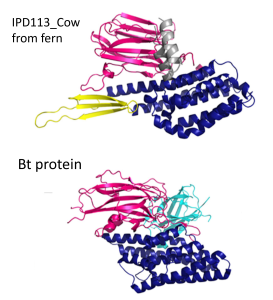 Insect pests pose a significant threat to global crop production, with lepidopteran species like corn earworm and armyworms causing substantial losses. The widespread use of insecticidal proteins from Bacillus thuringiensis (Bt) in crops has been a key strategy to combat these pests. However, the emergence of field-evolved resistance in various pest species raises concerns about the sustainability of Bt crops. This study focuses on the discovery of a new family of insecticidal proteins, IPD113, isolated from fern (Pteris) species. Building on earlier observations that ferns are naturally resistant to insect infestation, the researchers identified IPD113 as having strong activity against lepidopteran pests in artificial diet-based assays and transgenic plants. Interestingly, IPD113s proved successful in eliminating insect colonies that were resistant to popular Bt proteins. The IPD113_Cow, member of the IPD113 family revealed a similar structure to Bt insecticidal proteins. Genomic analyses confirmed that these proteins are encoded by plant genes, challenging the initial hypothesis of horizontal gene transfer from bacteria. The discovery of IPD113 offers a viable path for developing insect-resistant crops with a new mode of action, potentially addressing challenges associated with Bt resistance in agricultural settings. (Summary by Arpita Yadav @arpita_yadav_). Proc. Natl. Acad. Sci. USA 10.1073/pnas.2306177120.
Insect pests pose a significant threat to global crop production, with lepidopteran species like corn earworm and armyworms causing substantial losses. The widespread use of insecticidal proteins from Bacillus thuringiensis (Bt) in crops has been a key strategy to combat these pests. However, the emergence of field-evolved resistance in various pest species raises concerns about the sustainability of Bt crops. This study focuses on the discovery of a new family of insecticidal proteins, IPD113, isolated from fern (Pteris) species. Building on earlier observations that ferns are naturally resistant to insect infestation, the researchers identified IPD113 as having strong activity against lepidopteran pests in artificial diet-based assays and transgenic plants. Interestingly, IPD113s proved successful in eliminating insect colonies that were resistant to popular Bt proteins. The IPD113_Cow, member of the IPD113 family revealed a similar structure to Bt insecticidal proteins. Genomic analyses confirmed that these proteins are encoded by plant genes, challenging the initial hypothesis of horizontal gene transfer from bacteria. The discovery of IPD113 offers a viable path for developing insect-resistant crops with a new mode of action, potentially addressing challenges associated with Bt resistance in agricultural settings. (Summary by Arpita Yadav @arpita_yadav_). Proc. Natl. Acad. Sci. USA 10.1073/pnas.2306177120.
Graduate student mentorship as a target for diversifying biology
 The quality of student-advisor relationships is one of the top predictors of research progress and sense of belonging in science, yet in most cases the mentoring relationship is simply left to chance. In this preprint, Debray et al. surveyed a cohort of PhD students to understand what mentoring practices really support the students. The authors start with some interesting but not surprising statistics: 69% of faculty received no formal mentoring training, yet they rarely feel they mentor poorly. Conversely, nearly half of graduate students report frequent poor mentoring, and these students are disproportionally from minority groups. The study identified several strategies to improve how students are mentored. Good mentoring involves mentors who demonstrate empathy and welcome honest feedback, meet frequently with their mentees, and provide both positive encouragement and critical feedback. In cases where the mentor does not provide good support, the student can fill the gap with strong support from other students and faculty, as well as benefit from a supportive department. Note: The ROOT & SHOOT project is recruiting plant scientists at all career stages to participate in a Working Group on Culturally Responsive Mentoring – see https://rootandshoot.org/working-group-on-culturally-responsive-mentoring/. (Summary by Mary Williams @PlantTeaching) bioRxiv https://doi.org/10.1101/2023.08.18.553806
The quality of student-advisor relationships is one of the top predictors of research progress and sense of belonging in science, yet in most cases the mentoring relationship is simply left to chance. In this preprint, Debray et al. surveyed a cohort of PhD students to understand what mentoring practices really support the students. The authors start with some interesting but not surprising statistics: 69% of faculty received no formal mentoring training, yet they rarely feel they mentor poorly. Conversely, nearly half of graduate students report frequent poor mentoring, and these students are disproportionally from minority groups. The study identified several strategies to improve how students are mentored. Good mentoring involves mentors who demonstrate empathy and welcome honest feedback, meet frequently with their mentees, and provide both positive encouragement and critical feedback. In cases where the mentor does not provide good support, the student can fill the gap with strong support from other students and faculty, as well as benefit from a supportive department. Note: The ROOT & SHOOT project is recruiting plant scientists at all career stages to participate in a Working Group on Culturally Responsive Mentoring – see https://rootandshoot.org/working-group-on-culturally-responsive-mentoring/. (Summary by Mary Williams @PlantTeaching) bioRxiv https://doi.org/10.1101/2023.08.18.553806



